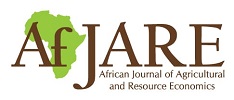


African Journal of Agricultural and Resource Economics (AfJARE)
A publication of the African Association of Agricultural Economists (AAAE)
Latest Publications
Evaluating households’ willingness to pay for private water supply services in Wakiso District, Uganda
Accessing water supply services remains a serious challenge in Wakiso District in Uganda, where most households travel long distances to collect water – a process that threatens their health, productivity and economic wellbeing.
The odds of South African agriculture using wildlife ranching to adapt to climate change
In this paper, we explore the role of wildlife in climate change adaptation, especially in areas used predominantly for livestock production in South Africa. Using a sample of 3 449 wildlife and livestock ranches, we estimate a multinomial choice model of various ranching options in these areas. The results indicate that mixed wildlife-livestock ranches are less vulnerable to climate change when compared to ranches with only wildlife or only livestock.
This study uses an online laboratory experiment and a post-experimental survey to test whether the Mastercard Foundation (MCF) scholarship programme causally influences the creation of cognitive social capital among University of Pretoria recipients.
Uganda’s climate is changing in terms of rising temperatures and altered precipitation patterns, leading to extreme meteorological conditions such as prolonged drought, floods and landslides. Yet the majority (68%) of Ugandans rely largely on rain-fed agriculture, which is affected by climate variability.
Determinants of arable crop farmers’ decisions to adapt to climate change risks in Nigeria
This study ascertained the influence of farmers’ perceptions of climate change effects and their household characteristics on the choice of adaptation technologies they adopt. The survey relied mainly on institutional and primary data for its analysis.
Determinants of bilateral trade flow between Ethiopia and its major trading partners: A gravity model approach
This study seeks to identify the internal and external factors determining Ethiopia’s bilateral exports and total trade flows. It uses panel data covering 21 major trading partners of Ethiopia from 2000 to 2017 and estimates an augmented fixed effects gravity model.
Volume 19
This study investigated the food security effect of the adoption of improved maize varieties among farming households in Uganda using four waves of the Uganda National Panel Survey (UNPS) spanning the period 2013 to 2020.
Soil acidity is a major constraint to crop production in tropical regions. Although agricultural lime is one option to remediate acid soils, there is limited information on the potential returns on investments to liming by smallholders.
Volume 18 (2023)
Volume 17 (2022)
Insect pollination improves the yield of most crop species and contributes to one-third of global crop production. The importance of this ecosystem service in improving agricultural production has largely been overlooked, however, in favour of practices that improve soil conditions such as fertiliser use and supplementary irrigation.
Recognising potential selection bias due to non-randomness of the data, this study used propensity score matching on data from a nationally representative fifth Integrated Household Survey (IHS5) to investigate the effect of agriculture extension services on the technical efficiency of maize farmers in Malawi.
There is an emerging body of studies assessing the influence of resilience on household food security in developing countries. Yet no study has systematically analysed this theme in Zimbabwe, an area that we address.


